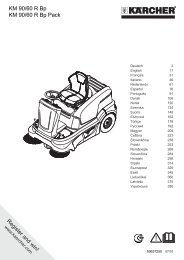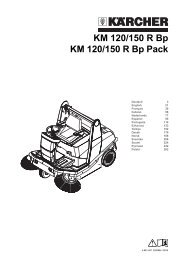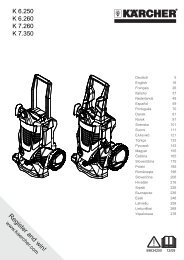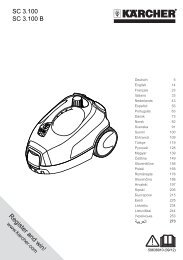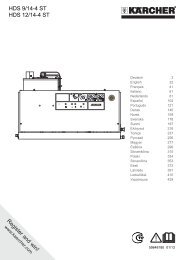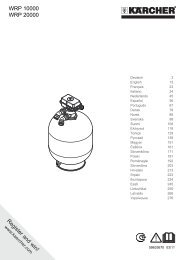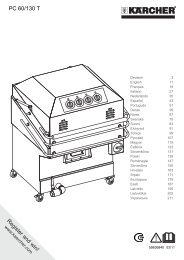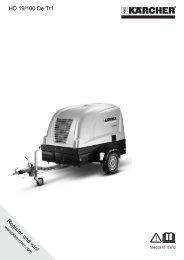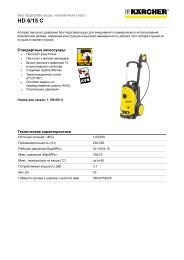KM 100/100 RP KM 100/100 R LPG - Kärcher Services GmbH
KM 100/100 RP KM 100/100 R LPG - Kärcher Services GmbH
KM 100/100 RP KM 100/100 R LPG - Kärcher Services GmbH
You also want an ePaper? Increase the reach of your titles
YUMPU automatically turns print PDFs into web optimized ePapers that Google loves.
Commissioning/Operations<br />
– Gas must always be drawn only from<br />
one cylinder. Drawing gas from multiple<br />
cylinders simultaneously can cause<br />
liquid gas from one cylinder flowing into<br />
the other. This causes the over-filled<br />
cylinder to be subjected to an unpermitted<br />
excess pressure when the cylinder<br />
valve is closed later (refer B.1 of these<br />
guidlines).<br />
– Ensure the correct positioning of the<br />
cylinder with the "top" marking while<br />
connecting a full cylinder (the connection<br />
screw points vertically upward).<br />
Replace cylinders carefully. While connecting<br />
and disconnecting the gas cylinders,<br />
the gas outlets of the cylinder valve<br />
must be closed properly by tightening the<br />
locking nuts with a spanner.<br />
– Discontinue the use of leaky gas cylinders.<br />
Such cylinders are to be emptied<br />
by slowly letting out the gas in open<br />
spaces by conforming to all safety regulations<br />
and are to be indicated as<br />
leaky. Also inform the issuing company<br />
or its representative (the filling-station<br />
attendant) in writing about the damage<br />
to the cylinder while delivering or receiving<br />
the cylinders.<br />
– Before connecting the gas cylinder,<br />
check that its connection neck is in a<br />
proper state.<br />
– After connecting the cylinder, regularly<br />
check that it is not leaky by using a<br />
foaming agent.<br />
– Open the valves slowly. Do not use<br />
hammers to open and close the cylinders.<br />
– Use only dry fire extinguishers (with<br />
carbonic acid gas) in case of fire<br />
caused by liquefied gases.<br />
– The entire <strong>LPG</strong> unit must be continuously<br />
checked to ensure that there are<br />
no leaks and the unit is functioning<br />
properly. Using the vehicle with a leaky<br />
gas unit is strictly prohibited.<br />
– First close the cylinder valve before<br />
loosening the pipe or tube connection.<br />
Unscrew and loosen the connection nut<br />
of the gas cylinder slowly because otherwise<br />
the gas under pressure in the<br />
tube will flow out instantly.<br />
– If the gas is refilled from a larger tank,<br />
then ask the sales agent of the <strong>LPG</strong><br />
about the important regulations to be<br />
followed.<br />
Danger<br />
Risk of injury!<br />
– <strong>LPG</strong> in a liquid state can cause frost<br />
bites on bare skin.<br />
– After disconnecting the cylinder, tighten<br />
the closing nut firmly on the connecting<br />
threading of the cylinder.<br />
– Use soap water or some such foaming<br />
agent to check whether the cylinder is<br />
leaking. The use of open flames to illuminate<br />
the <strong>LPG</strong> unit is strictly prohibited.<br />
18 EN<br />
– Follow the manufacturer's installation<br />
specifications while changing individual<br />
parts of the <strong>LPG</strong> unit. Close all cylinder<br />
and locking valves while doing so.<br />
– Regularly check the status of the electrical<br />
unit of the <strong>LPG</strong> vehicles . Sparks<br />
can cause explosions if the gas-carrying<br />
parts of the unit are leaky.<br />
– If a <strong>LPG</strong>-driven vehicle has been idling<br />
for a long time, then first ventilate the<br />
setting room before commissioning the<br />
vehicle or its electrical unit.<br />
– Immediately inform the trade association<br />
and the concerned trade supervisory<br />
authority about accidents with gas<br />
cylinders or <strong>LPG</strong> units. Store the damaged<br />
parts carefully until all investigations<br />
have been completed.<br />
In the installation and storage rooms as<br />
well as the workshops<br />
– Propellants or <strong>LPG</strong> cylinders must always<br />
be stored according to the regulations<br />
of TRF 1996 (Technical<br />
Regulations for Liquid Gases, refer DA<br />
to BGV D34, Appendix 4).<br />
– Always store the gas cylinders in a vertical<br />
position. Use of open flames and<br />
smoking at the installation site of the<br />
cylinders and during repairs is strictly<br />
prohibited. Protect the stored cylinders<br />
against unauthorised access. Close all<br />
empty cylinders properly.<br />
– Close the cylinder and main locking<br />
valves immediately when you switch off<br />
the vehicle.<br />
– Follow the regulations for garages and<br />
the construction guidelines of the respective<br />
State about the location and<br />
structure of the parking areas for <strong>LPG</strong>driven<br />
vehicles.<br />
– Gas cylinders are to be stored in separate<br />
rooms away from the parking areas<br />
(refer DA to BGV D34, Appendix 2).<br />
– The electrical hand-held lamps used in<br />
the rooms are to be equipped with<br />
closed, sealed case and a strong protection<br />
cover.<br />
– Close all cylinder and main valves before<br />
working in repair workshops and<br />
protect the gas cylinders against effect<br />
of external heat.<br />
– A responsible person must check that<br />
all valves, especially the cylinder<br />
valves, are closed during operational<br />
breaks and before closing the factory.<br />
Do not carry out any jobs involving fire -<br />
such as cutting and welding jobs - in the<br />
vicinity of the gas cylinders. Do not<br />
store gas cylinders, not even empty<br />
ones, in the workshops.<br />
– The parking and storage rooms and the<br />
repair workshops must be ventilated<br />
properly. Please note that liquefied<br />
gases are heavier than atmospheric air.<br />
They get collected on the floor, in recesses<br />
and other holes in the floors and<br />
form a gas-air mixture that can lead to<br />
explosions.<br />
- 2<br />
Function<br />
The sweeper operates using the overthrow<br />
principle.<br />
– The side brushes (3) clean the corners<br />
and edges of the surface, moving dirt<br />
and debris into the path of the roller<br />
brush.<br />
– The rotating roller brush (4) moves the<br />
dirt and debris directly into the waste<br />
container (5).<br />
– The dust raised in the container is separated<br />
by the dust filter (2) and the filtered<br />
clean air is drawn off by the<br />
suction fan (1).



